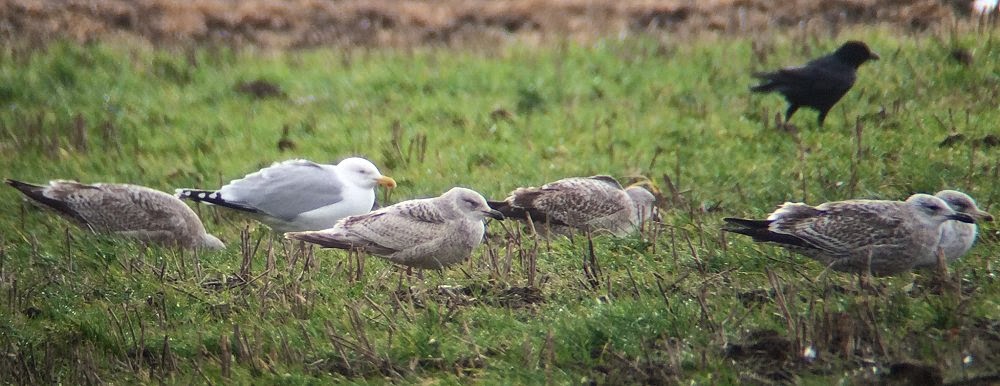Well this wasn't a species I thought I'd be writing about again any time soon, and certainly not at another inland English location...
Monday 2nd March was a bitterly cold but sunny day with wintry showers rattling through on a brisk westerly at work near Goole, but by early afternoon I was finished and heading north. I'd promised myself a stop at Rufforth but on arrival there were no gulls in the fields on the bypass, and none along the B1224 either. Even the tip looked a bit quiet on first impressions, but as I pulled into the airfield, a few hundred large gulls were on the runway, so I settled down to watch them from the comfort of my car.One of the first birds I looked at was a first-winter Caspian Gull, followed by a big beefy 'northern' Argentatus with milky brown primaries. Another pale-winged bird caught my eye, having some of the jizz of an Iceland-type, but the coverts looked oddly bleached and the mantle contrastingly dark, and thoughts quickly turned to mixed genes. There were suggestions of Kumlien's there, but I never saw the spread wing as it suddenly disappeared, so who knows. A few birds further along was a second-winter Iceland Gull, presumably the bird that's been present for a few weeks, but good to see nonetheless.
With an impressive tally of gulls already on the daylist, I moved around to the other side of the airfield, where I bumped into local guller Chris Gomersall. Soon afterwards one of the light aircraft trundled out from the hangars, which we hoped might just shuffle things a little, but in fact it cleared the airfield of gulls! I settled on watching a few hundred birds in the adjacent sheepfield whilst Chris headed off, and after a while a distinctive head caught my eye. All the gulls were head-on, facing me and the wind, so it was difficult to see plumage details, but this striking bird, with a large-looking dark eye in a rounded head, and a fairly small, pinkish-based bill, made me stop in my tracks. The breast and belly were the colour of the stone-cold latte next to me, and undeniably smooth, American smooth in fact. I flirted with the outrageous suggestion of Thayer's Gull, but I'd been here before, and I'd not even seen its wings yet!
I stuck with it as it snoozed behind other birds, or drank from the puddle in the field, and gradually it revealed itself to me. The greater coverts formed a muddy bar with finely marked tips, whilst the lesser and median coverts were intricately marked and quite unlike the surrounding Herrings. The mantle and scaps were a bit messy, and details were hard to see, but the tertials were fractionally darker than the greater coverts, with broad, lacy white tips. The primaries were the darkest part of the closed wing, but they weren't black, and on occasion I could see creamy chevrons at the tips. Maybe my first instinct wasn't quite so outrageous, but how to prove it, my phone-scoped images were awful given the light and distance.
I knew that I needed to see it fly, but it looked pretty settled, and even if they did take off, they'd fly straight at me, not the best angle to view primary patterns... Sure enough, when something disturbed the flock, the bird lifted and I just snapped away, hoping for the best. They came down again and I flicked through the images on my phone. There was a suggestion of a silvery underwing and dark tips to the undersides of the outer primaries, but it'd be tricky to prove it wasn't photographic effect, and there was nothing of the tail.
Then the flock flew again, and this time poured over the trees and onto the airfield! I repositioned myself and scanned through the ranks of gulls, now closer and lined up side-on ready for inspection. Nothing. I scanned again, trying not to get too buffeted by the wind, and suddenly there it was, right on the front edge of the flock. I snapped away, and it flew a short distance to join a group of Herring Gulls, but that was all I needed. It was a Thayer's Gull, and a belter! The outer five primaries had dark outer webs flicking back around the tips like the clichéd Nike tick, whilst the inner primaries were paler with dark spots at the tips. The secondaries formed a smooth dark bar, as dark as the outer primaries, and the underwing was beautifully silvered. The tail was largely dark and smooth, and the rump and uppertail coverts were heavily barred.
I was straight on the phone to Stu at RBA to tell him that lightning can indeed strike twice, and the news was out. I tweeted a few images to comfort the doubters, and settled back to enjoy it. Minutes later however, a dog-walker appeared, and the flock flew, this time failing to resettle, and the few rapid-response twitchers failed to connect. It was reported by a single observer the next day, but not since.
Twice in one lifetime... bonkers!











No comments:
Post a Comment